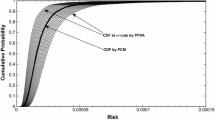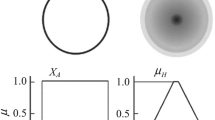Abstract
In risk assessment studies it is important to determine how uncertain and imprecise knowledge should be included into the simulation and assessment models. Thus, proper evaluation of uncertainties has become a major concern in environmental and health risk assessment studies. Previously, researchers have used probability theory, more commonly Monte Carlo analysis, to incorporate uncertainty analysis in health risk assessment studies. However, in conducting probabilistic health risk assessment, risk analyst often suffers from lack of data or the presence of imperfect or incomplete knowledge about the process modeled and also the process parameters. Fuzzy set theory is a tool that has been used in propagating imperfect and incomplete information in health risk assessment studies. Such analysis result in fuzzy risks which are associated with membership functions. Since possibilistic health risk assessment studies are relatively new, standard procedures for decision-making about the acceptability of the resulting fuzzy risk with respect to a crisp standard set by the regulatory agency are not fully established. In this paper, we are providing a review of several available approaches which may be used in decision-making. These approaches involve defuzzification techniques, the possibility and the necessity measures. In this study, we also propose a new measure, the risk tolerance measure, which can be used in decision making. The risk tolerance measure provides an effective metric for evaluating the acceptability of a fuzzy risk with respect to a crisp compliance criterion. Fuzzy risks with different membership functions are evaluated with respect to a crisp compliance criterion by using the possibility, the necessity, and the risk tolerance measures and the results are discussed comparatively.







Similar content being viewed by others
References
Bardossy A, Bogardi I, Duchstein L (1991) Fuzzy set and probabilistic techniques for health-risk analysis. Appl Math Comput 45:241–268
Bonano EJ, Apostolakis GE, Salter PF, Ghassemi A, Jennings S (2000) Application of risk assessment and decision analysis to the evaluation, ranking and selection of environmental remediation alternatives. J Hazard Mater 71:35–57
Christakos G, Serre ML (2000) Spatiotemporal analysis of environmental exposure-health effect associations. J Expo Anal Environ Epidemiol 10:168–187
Côme B, Guyonnet D, Magnouni S (1997) Apports potentiels de la théori des possibilitiés á l’évaluation des risques environnementaux. Déchets-Sci Tech 7:40–46
Cullen AC, Frey HC (1999) Probabilistic techniques in exposure assessment. Plenum Press, New York
Delgado M, Vila MA, Voxman W (1998b) A fuzziness measure for fuzzy numbers: applications. Fuzzy Sets Syst 94:205–216
Dou C, Woldt W, Bogardi I, Dahab M (1995) Steady-state groundwater flow simulation with imprecise parameters. Water Resour Res 31(11):2709–2719
Dubois D, Prade H (1988) Possibility theory. An approach to computerized processing of uncertainty. Plenum Press, New York
EPA US (2000) Presenter’s manual for: “superfund risk assessment and how you can help”. EPA/540/R-99/013, U.S. EPA Office of Solid Waste and Emergency Response
EPA US (2001) Risk assessment guidance for superfund (RAGS), vol III— Part A, process for conducting probabilistic risk assessment. Office of emergency and remedial response, Washington, DC
Ferson S, Ginzburg LR (1996) Different methods are needed to propagate ignorance and variability. Reliabil Eng Syst Safety 54:133–144
Guyonnet D, Côme B, Perrochet P, Parriaux A (1999) Comparing two methods for addressing uncertainty in risk assessment. J Environ Eng 125(7):660–666
Guyonnet D, Bourgine B, Dobois D, Fargier H, Côme B, Chilés J-P (2003) Hybrid approach for addressing uncertainty in risk assessment. J Environ Eng 129(1):68–78
Kandel A (1986) Fuzzy mathematical techniques with applications. Addison-Wesley Publishing Company, Reading
Kaufmann A, Gupta MM (1985) Introduction to fuzzy arithmetic. Theory and Applications, Van Nostrand Reinhold Company Inc., New York
Kelly EJ, Campbell K (2000) Separating variability and uncertainty in environmental risk assessment-making choices. Hum Ecol Risk Assess 6(1):1–13
Kentel E (2006) Uncertainty modeling in health risk assessment and groundwater resources management. PhD Thesis, Georgia Institute of Technology
Kentel E, Aral MM (2004) Probabilistic-fuzzy health risk modeling. Stochast Environ Res Risk Assess 18:324–338
Kentel E, Aral MM (2005) 2D Monte Carlo versus 2D fuzzy Monte Carlo health risk assessment. Stochast Environ Res Risk Assess 19:86–96
Kikuchi S, Pursula M (1998) Treatment of uncertainty in study of transportation: fuzzy set theory and evidence theory. J Transport Eng 124(1):1–8
Klir GJ, Yuan B (1995) Fuzzy sets and fuzzy logic: theory and applications. Prentice-Hall, Inc., Upper Saddle River
Klir GJ, Yuan B (1996) Fuzzy sets, fuzzy logic, and fuzzy systems—selected papers by Lotfi A. Zadeh. In: Zadeh LA, Hirota K, Klir GJ, Sanchez E, Wang P-Z, Yager RR (eds) Advances in fuzzy systems—application and theory. World Scientific Publishing Co Pvt Ltd, Singapore, 826 p
Lein JK (1992) Expressing environmental risk using fuzzy variables: a preliminary examination. Environ Prof 14:257–267
Liu L, Cheng SY, Guo HC (2004) A simulation-assessment modeling approach for analyzing environmental risks of groundwater contamination at waste landfill sites. Hum Ecol Risk Assess 10:373–388
Mohamed AMO, Côté K (1999) Decision analysis of polluted sites—a fuzzy set approach. Waste Manage 19:519–533
Pedrycz W (1995) Fuzzy sets engineering. CRC Press Inc., Boca Raton
Schuhmacher M, Meneses M, Xifro A, Domingo JL (2001) The use of Monte-Carlo simulation techniques for risk assessment: study of a municipal waste incinerator. Chemosphere 43:787–799
Vose D (1996) Quantitative risk analysis—a guide to Monte Carlo simulation modelling. Wiley, Chichester
Wang L-X (1997) A course in fuzzy systems and control. Prentice-Hall, Inc., Upper Saddle River
Wonneberger S, Kistinger S, Deckert A (1995) Nuclear science and technology. Unbiassed guess, a concept to cope with fuzzy and random parameters? European Commission, Luxembourg
Woodbury AD, Dudicky EA (1991) The geostatistical characteristics of the borden aquifer. Water Resour Res 27(4):533–546
Yager RR, Filev DP (1994) Essentials of fuzzy modeling and control. Wiley, New York
Zadeh LA (1965) Fuzzy sets. Inf Control 8:338–353
Zadeh LA (1978) Fuzzy sets as a basis for a theory of possibility. Fuzzy Sets Syst 1:3–23
Author information
Authors and Affiliations
Corresponding author
Rights and permissions
About this article
Cite this article
Kentel, E., Aral, M.M. Risk tolerance measure for decision-making in fuzzy analysis: a health risk assessment perspective. Stoch Environ Res Risk Assess 21, 405–417 (2007). https://doi.org/10.1007/s00477-006-0073-2
Published:
Issue Date:
DOI: https://doi.org/10.1007/s00477-006-0073-2




